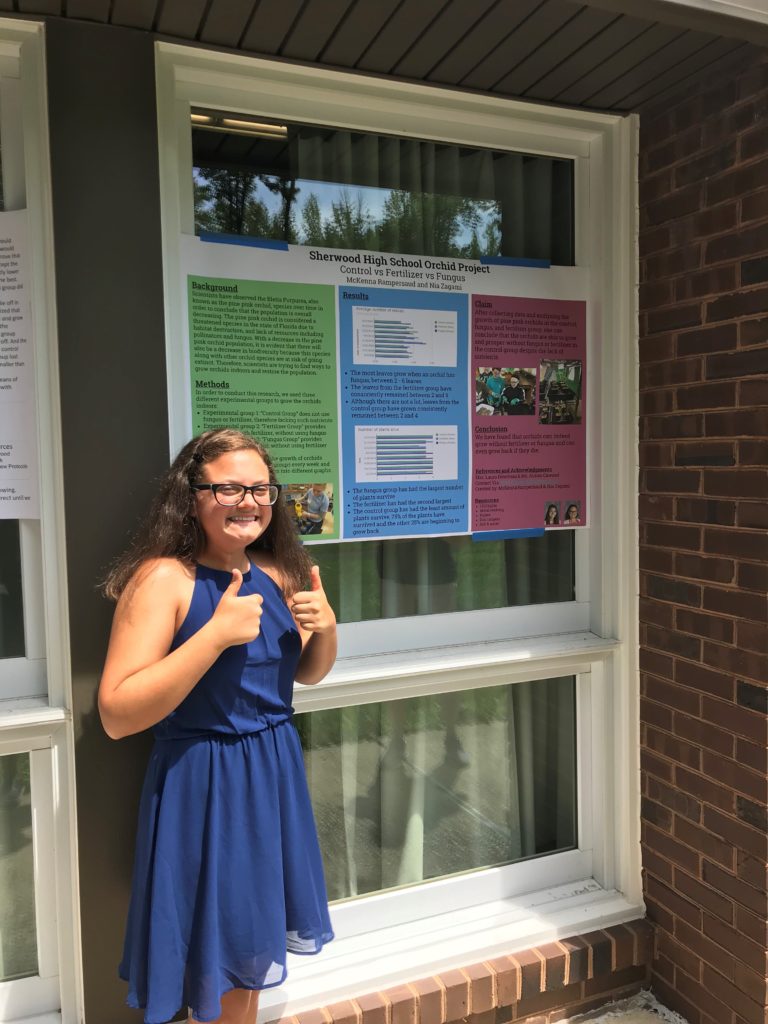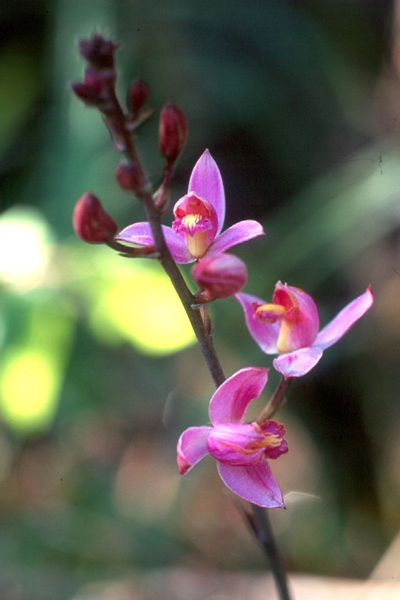by Anika Mittu, student contributor

High school sophomore Nia Zagami and her classmates collected data on conserving threatened pink pink orchids, which brought her in front of an audience of scientists at the Native Orchid Conference this year. (Credit: Tony Zagami)
While preparing two students to speak at the 2018 Native Orchid Conference held at the Smithsonian Environmental Research Center this summer, citizen science coordinator Alison Cawood assured them that their presentation on pine pink orchids would be low stress.
Sitting in the back of the conference room and smoothing over their dresses, the students felt otherwise.
“I feared that I would not be smart enough to share the data, and that I would mess up or look clueless,” said Nia Zagami, a sophomore at Sherwood High School and presenter at the conference. “Knowing that I was just a high schooler who was expected to speak in front of scientists and orchid enthusiasts really made me nervous.”
The nerves didn’t fade until Zagami, joined by fellow Sherwood sophomore and presentation collaborator Sudha Sudhaker, walked to the front of the conference room and adjusted her microphone multiple times. And then, the pair eased into their normal student voices to explain their own data and what citizen science means to them. An audience of blank stares began grinning.
Zagami and Sudhaker had recently finished their second semester of Honors Biology under teacher Laura Dinerman. Although Honors Biology is a common science course for underclassmen at Sherwood, Dinerman’s 60 students taking the course during spring 2018 did something decidedly less common: a professional conservation experiment. Dinerman’s class measured the growth of the pine pink orchid (Bletia purpurea). Though common in the tropics, in the continental U.S. the pine pink orchid grows only in Florida, where it’s threatened. The students grew the orchids under different soil nutrient conditions (fungi, fertilizer or unchanged soil) in their classroom, as part of a citizen science project led by the Smithsonian.
“In other science classes, we would get a packet from the curriculum and it would have everything planned out. Every outcome was already known, and we weren’t doing real research. It was always fake. But this project was real,” said Zagami. “People genuinely did not know the outcome, and knowing that I got to be a part of a real research project and help them find the outcome is really what made me enjoy this project.”
Through the process of watering and measuring orchid growth every week, Zagami and Sudhaker became citizen scientists—a meaningful addition to their school routines.
“We were in charge of measuring and recording all the data ourselves,” Sudhaker said. “Collecting the data was one of the most exciting parts, because we got to see how the plants were growing.”

Pine Pink Orchid, Bletia purpurea. (Credit: David McAdoo)
The independence given to Zagami, Sudhaker and their peers is a rarity in science classes throughout most high schools. Thankfully, teacher Laura Dinerman clashes with the idea of “cookie-cutter science,” where students are given lab packets that assume an outcome to a given experiment.
“I always find that students have been excited about citizen science,” said Dinerman, who tries to make her classes as active and student-driven as possible.
Judging by the two sophomores at the front of the room, Dinerman was right. Citizen science creates passion. During the presentation, Zagami gushed about watching orchids grow out of the simple planting pots and into the very air around her. Some of the conference attendees laughed at what seemed to be such a simple part of data collection. But many sat taller in their seats, mesmerized by the joy that Zagami couldn’t contain. The thought that an act as simple as growing orchids could cause her joy made Zagami’s energy even more infectious.
“The earlier that students get the chance to do real science, the more enthusiastic they are,” said Dinerman. Her newest citizen scientists are living proof.
Anika Mittu is a teenage journalist and current senior at Sherwood High School in Sandy Spring, Maryland. This is her third year volunteering with the Smithsonian Environmental Research Center through her high school environmentalism club. She hopes to inspire people to care about the overlooked aspects of the world, which often includes the environment and science news.

